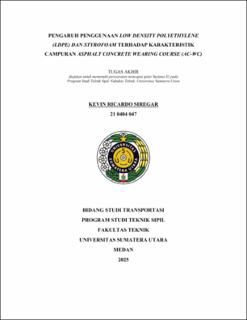Pengaruh Penggunaan Low Density Polyethylene (LDPE) dan Styrofoam terhadap Karakteristik Campuran Asphalt Concrete Wearing Course (AC-WC)
The Effect of Using Low Density Polyethylene (LDPE) and Styrofoam on The Characteristics Of Asphalt Concret Wearing Course (AC-WC) Mixtures

Date
2025Author
Siregar, Kevin Ricardo
Advisor(s)
Lubis, Adina Sari
Aswin, Muhammad
Metadata
Show full item recordAbstract
Modified asphalt is an innovative solution to improve flexible pavement performance, especially against traffic loads and extreme environmental conditions. Adding additives such as plastic waste and Styrofoam improves the mechanical performance of asphalt and offers a solution to environmental problems caused by plastic waste. Low-density polyethylene (LDPE) waste and styrofoam are two types of plastic waste that have the potential to be used as additives in asphalt mixtures. Various studies have shown that adding LDPE and styrofoam can increase the stability, strength, and durability of asphalt, although each has different characteristics on the flexibility and stiffness of the mixture. This study evaluates the effect of adding Styrofoam and LDPE waste in the Asphalt Concrete Wearing Course (AC-WC) mixture.
The asphalt mixing method is carried out using the wet method, namely, mixing styrofoam and LDPE directly with asphalt. In its implementation, asphalt is first mixed with the addition of styrofoam waste, with variations in content of 7%, 8%, and 9% of the asphalt weight. Furthermore, asphalt mixing was carried out using the optimum styrofoam content and adding LDPE waste with variations in content of 6%, 6.5%, 7%, 7.5%, and 8% of the asphalt weight. The tests carried out were Marshall testing, Wheel Tracking Machine (WTM) testing, and Extraction testing as a control of asphalt content.
The study results show that adding additives in the form of styrofoam and LDPE affects the characteristics of the asphalt mixture, such as increasing the stability value and dynamic stability. The highest stability and dynamic stability values were obtained with the addition of 9% styrofoam and 8% LDPE, which were 1707 kg for the stability value and 3402.83 lines/mm for the dynamic stability value. From the results of the Marshall and WTM tests, it can be concluded that adding additives in the form of styrofoam and LDPE will increase the strength and quality of the AC-WC mixture.
Collections
- Undergraduate Theses [1609]
